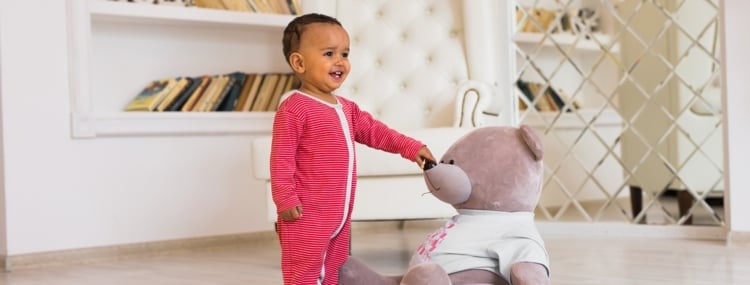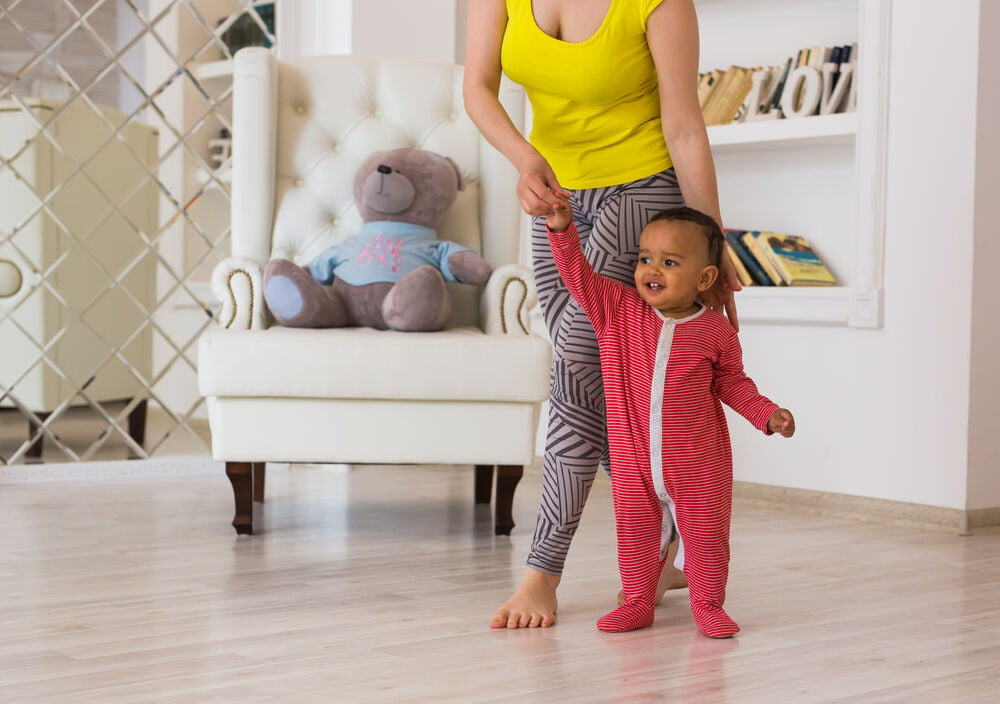One of the most memorable turning points in a child's development comes with baby standing. From the time they start pulling themselves up to the moment they take their first steps, it's an amazing part of their journey. This article discusses what to expect and how to help.
-
Tracking cycle
-
Getting pregnant
-
Pregnancy
-
Help Center
-
Flo for Partners
-
Anonymous Mode
-
Flo app reviews
-
Flo Premium New
-
Secret Chats New
-
Symptom Checker New
-
Your cycle
-
Health 360°
-
Getting pregnant
-
Pregnancy
-
Being a mom
-
LGBTQ+
-
Quizzes
-
Ovulation calculator
-
hCG calculator
-
Pregnancy test calculator
-
Menstrual cycle calculator
-
Period calculator
-
Implantation calculator
-
Pregnancy weeks to months calculator
-
Pregnancy due date calculator
-
IVF and FET due date calculator
-
Due date calculator by ultrasound
-
Medical Affairs
-
Science & Research
-
Pass It On Project New
-
Privacy Portal
-
Press Center
-
Flo Accuracy
-
Careers
-
Contact Us
When Do Babies Stand Alone, and How Can You Help Them?


Every piece of content at Flo Health adheres to the highest editorial standards for language, style, and medical accuracy. To learn what we do to deliver the best health and lifestyle insights to you, check out our content review principles.
When do babies start pulling up?
Both mothers and babies go through significant changes in their first year. For your little one, many different kinds of development come together, in this case leading to them pulling themselves up and from there to baby standing. They have to acquire:
- A set of involuntary posture control processes that lets them keep their balance against gravity
- Weight bearing on their legs and feet
- Gross motor skills to operate and coordinate their body's large muscles
It's important to remember that every baby is different and develops at their own pace. The milestones we talk about on the way to your baby pulling up alone are just rough guidelines to help you recognize the stages and provide the right learning activities for your little one.
Their legs support some weight (3–5 months):
At this point, your child's legs start to be able to support part of their weight for very short spans. They won't be able to maintain a standing position without a parent's help. You can encourage them by holding their hands or feet while pushing them along a flat, hard surface. Also at this age they can roll over.
Their legs can support most of their weight (5–6 months):
At this stage, balance is more of an issue for baby than strength. They can now support most of their weight, though they'll still need a parent's help from time to time to keep them upright. Parents can gauge how much of their baby's weight is being carried by gradually pulling back from holding them up until they're just providing support with one hand.
They start to bounce (6–7 months):
By the time they're able to stand with help for a few seconds, baby will start to bounce as they stand. Moreover, they roll prone to supine and can transfer objects hand to hand. This tends to be an exciting development for them, and you can expect bouncing to grow into a favorite pastime.
They start using supports (6–11 months):
Babies now start to pull themselves up using furniture at their height. In addition to that, they start cruising (walking holding furniture) and sit well unsupported. It's a good idea to make sure that any furniture that meets this description is stable, so it doesn't fall on them.
When do babies stand alone?
Overlapping with the latter stage of baby pulling themselves up are the stages of baby standing alone. This starts out as brief experiments with balance that will grow gradually longer.
By 10 months to a year, baby is generally able to stand for brief periods of time without support. It will be for just a few seconds at first, gradually increasing as baby practices moving around, letting go of supports, and even practicing taking small steps holding your hands.
By the age of about 11 to 14 months, they'll be able to stand fully and use their hands. From there, they will start learning how to do more complicated things, including bending and sitting down in a controlled way from a standing position.
When to be concerned about milestones
It's natural to want to be sure that your baby is healthy and normal and that you're doing your best to keep them that way, but it's also good to avoid losing sleep about when your baby is hitting certain milestones, Still, if your baby isn't toddling by 14 or 15 months, it's a good idea to bring this up with their pediatrician. It's the right time to double-check and make sure nothing is delaying the milestone.
How can you help your baby stand?

There are a variety of ways you can help and encourage your baby to stand alone, and there's one option it's usually best to avoid.
Steer clear of crawl & stand toys
Walkers certainly will make baby more mobile, but this isn't necessarily a good thing if it takes them into settings they might not be ready to cope with (especially stairwells). They also provide mobility at the expense of teaching a forward-leaning standing position that's dependent on the walker, which baby will later have to unlearn in order to stand by themselves.
Create a safe environment
Baby's urge to explore is one of the surest ways for them to develop the confidence to start standing. To make sure they can do this safely, put shatter-prone objects, potentially poisonous substances, and choking hazards out of reach. Remove furniture with sharp edges and lightweight objects they might be tempted to use to pull up, and anchor bookcases and televisions to the walls. Cover electrical outlets, use stairway gates, and make sure doors and cabinets have childproof locks.
Motivate your baby to explore
A little added motivation can be just the thing to prompt your baby to experiment. Try placing favorite toys or objects of interest just out of reach, atop low, sturdy furniture, and encourage them to pull up to stand.
Set up play dates
Put together play dates with friends or relatives who have little ones of a similar age. Playing with other babies will give them more examples of behaviors to imitate, as well as just being fun.
Give them lots of encouragement
Knowing you're their biggest fan will make a huge difference in your baby's confidence. With plenty of clapping, smiling, and encouragement from you, they'll be more willing to try new things. If they fall down or get frustrated, you can help by showing them certain motions such as bending the knees and urging them to give it a try.
A baby's journey from crawling to standing is one of the most magical parts of their first year of development. With the right precautions and the right encouragement, you'll be a vital part of your baby's discovery of the joy of standing.
Take a quiz
Find out what you can do with our Health Assistant


Hey, I'm Anique
I started using Flo app to track my period and ovulation because we wanted to have a baby.


The Flo app helped me learn about my body and spot ovulation signs during our conception journey.


I vividly
remember the day
that we switched
Flo into
Pregnancy Mode — it was
such a special
moment.
Real stories, real results
Learn how the Flo app became an amazing cheerleader for us on our conception journey.




